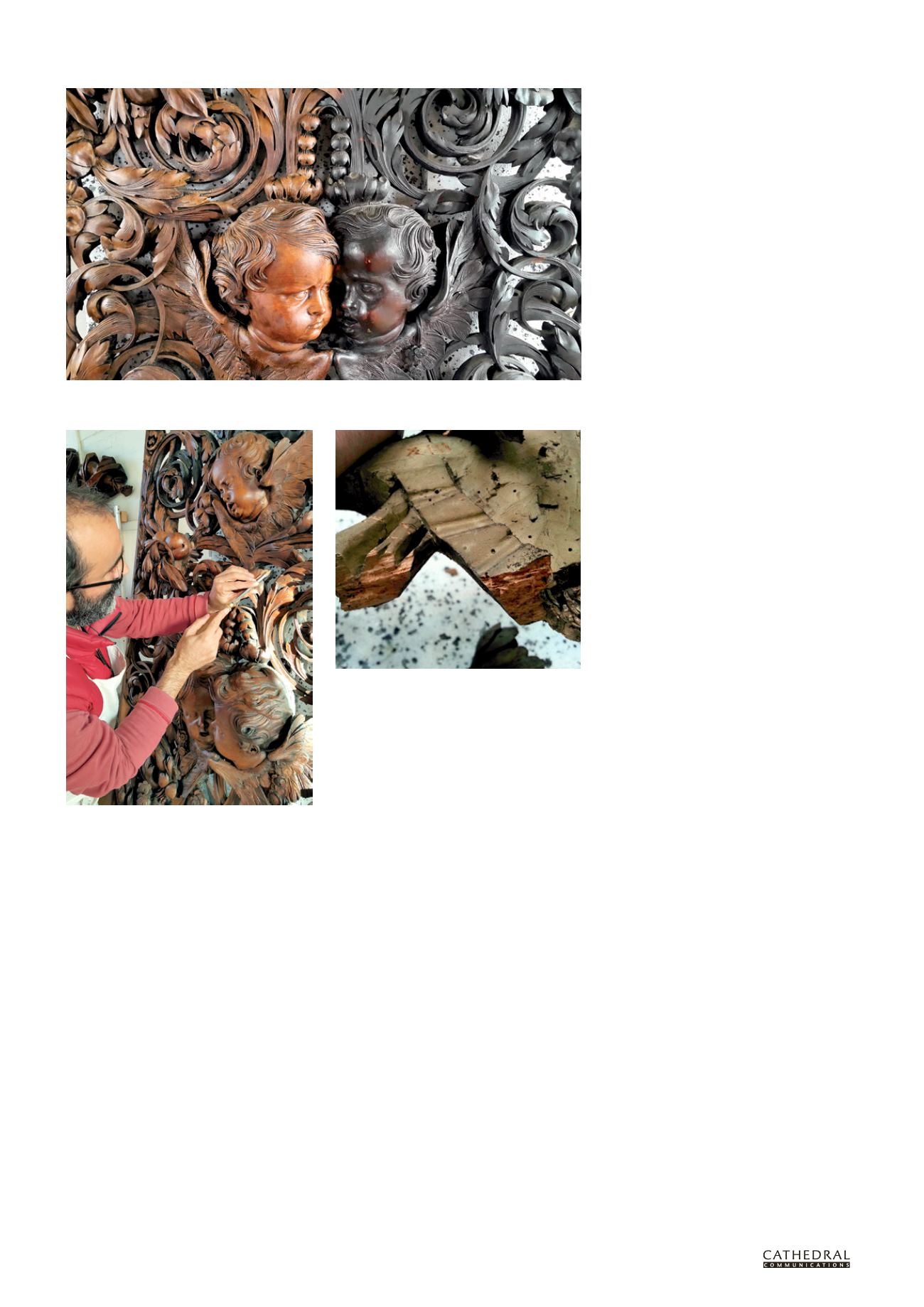

44
BCD SPECIAL REPORT ON
HISTORIC CHURCHES
24
TH ANNUAL EDITION
Using mid-19th and early 20th-
century photographs, Alan Lamb was able
to determine which elements had been
lost over time and a number of these were
replaced. The decision on what to replace
was generally guided by the ‘six-foot rule’:
if it can’t easily be seen from six feet away,
don’t replace it.
After careful test cleaning and analysis
of the layers of the varnish and paint
it was discovered that for at least the
first 50 years the carved limewood had
been left undecorated. Having become
very dirty and dusty, it had been given
a ‘reviving’ coat of oil-based lead paint
directly over the original surface finish
(without even attempting to clean it, a
layer of dirt was clearly visible under
the first application of paint). This was
an attempt to replicate the original
realised that the Evangelists at the north
east and south west had been swapped
sometime after this date. The beardless
Evangelist (St John) has now been
correctly replaced with his eagle, facing
into the chapel.
The two magnificent pierced panels
in the antechapel screen are also
carved in Bermudan cedar. Thorough
cleaning to reveal the original finish
has shown them to be carved to an
exceptionally high standard and, like
the limewood, to be some of Grinling
Gibbons’ best work. Late Victorian
photographs showed that these screens
had previously faced the other way,
which is how they have been reinstated:
the putti now face outwards into the
antechapel, as originally intended.
The pierced cedar panels and the
figures on the pediment had been
finished in a thick, dark varnish,
obscuring the quality of the original
carving. A key piece of research
indicated that this dark scheme was a
Victorian intervention. In 1867, following
a visit to Trinity, Mr WG Rogers
presented a paper to the Royal Institute
of British Architects in which he noted:
When I was there, I complained to
the verger that I could not make
out the faces of the angels on the
altar pediment, but when I put my
hand on the open worked panels, I
found they had been painted over
with a thick oil darkened with
Vandyke brown as sticky and moist
as if it had been done over less
than a week ago.
Since even unboiled linseed oil would
have dried within a couple of months,
Rogers’ account helped to establish the
date of the dark varnish quite accurately
and corroborated the analysis of the
varnish report.
Many of the chapel’s important wood
carvings had retained this dark finish
for 150 years, so ‘winding the clock back’
to before the Victorian intervention
was a drastic proposal. However, the
combination of the varnish analysis and
historical research convinced the college
and the diocesan advisory committee to
allow the carvings to be returned to the
appearance that Grinling Gibbons and
Bathurst intended. As much of the dark
varnish as could safely be removed was
carefully lifted to reveal the carvings
beneath in their original glory.
In the process of cleaning the
woodwork, the restorers were able
to discern the marks of the different
carvers, adding greatly to the
understanding of how Grinling Gibbons’
workshop carried out the work.
appearance and colour of the limewood
and since then it has been repainted
several times.
Alan Lamb’s team cleaned off as
much of the paint and varnish as possible
without damaging the underlying wood,
and recreated the most significant missing
elements, leaving carvings that are now
close to their original appearance.
THE SCREEN
The figures of the Evangelists, which rest
on the pediment of the antechapel screen
along with their symbols – a winged bull,
an eagle, a winged lion and an angel – as
well as the two Victories on the pediment
of the reredos, are carved in oak and rare
Bermudan cedar (
Juniperus bermudiana
).
This type of cedar is no longer available
because the trees are endangered, but
fortunately one of the college’s generous
donors found a small supply of old timber
which enabled repairs to be carved from
matching wood.
When the Evangelists were
being reinstalled, Alan Lamb’s team
encountered difficulty in fitting the
eagle to the figure at the north east.
On checking a 1914 photograph it was
The partially cleaned faces of putti from the antechapel screen: the thick varnish had been applied in the 1860s,
obscuring fine detail in the Bermudan cedar carvings
Woodworm damage in carvings of the reredos
Conservator David Mendieta carving a repair to
replace a missing leaf tip


















